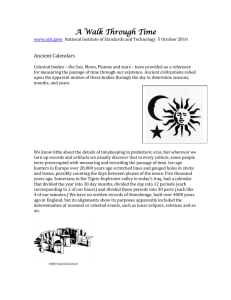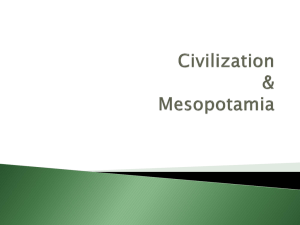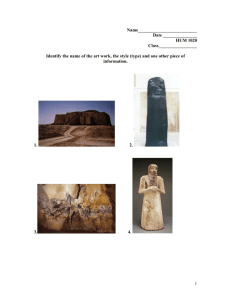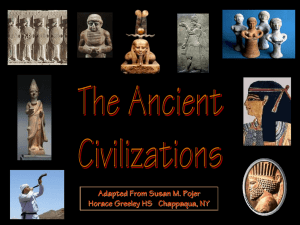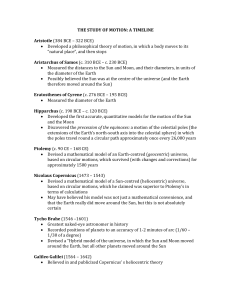History of Mathematics Math 3010, Spring 2001 Lecture Outline
advertisement
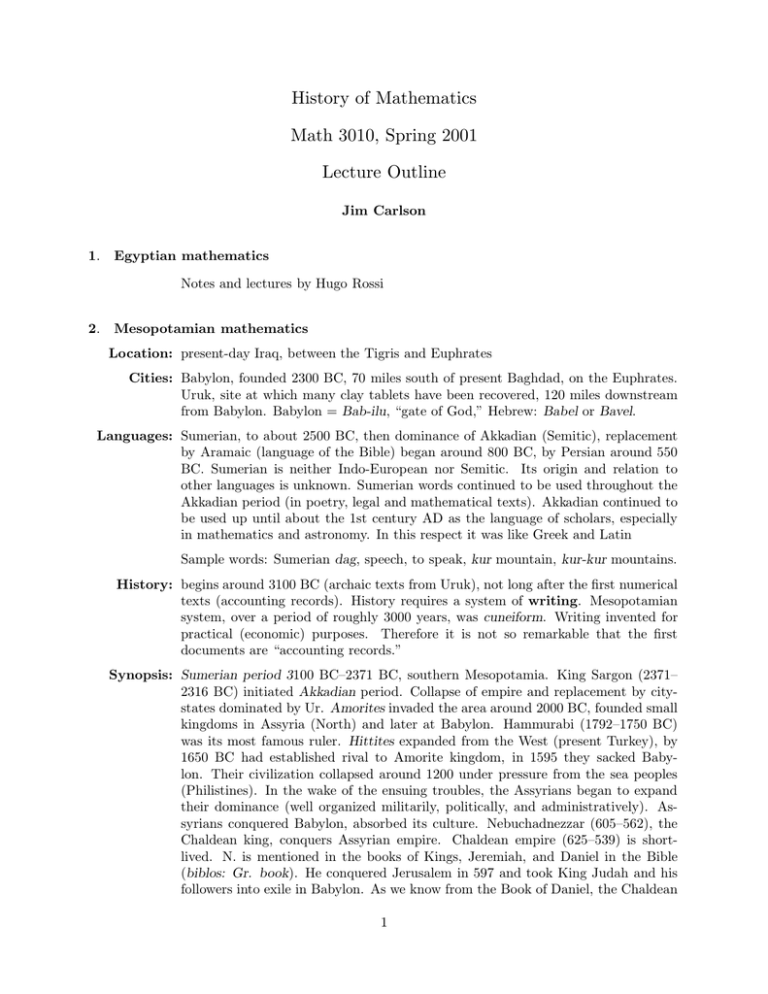
History of Mathematics Math 3010, Spring 2001 Lecture Outline Jim Carlson 1. Egyptian mathematics Notes and lectures by Hugo Rossi 2. Mesopotamian mathematics Location: present-day Iraq, between the Tigris and Euphrates Cities: Babylon, founded 2300 BC, 70 miles south of present Baghdad, on the Euphrates. Uruk, site at which many clay tablets have been recovered, 120 miles downstream from Babylon. Babylon = Bab-ilu, “gate of God,” Hebrew: Babel or Bavel. Languages: Sumerian, to about 2500 BC, then dominance of Akkadian (Semitic), replacement by Aramaic (language of the Bible) began around 800 BC, by Persian around 550 BC. Sumerian is neither Indo-European nor Semitic. Its origin and relation to other languages is unknown. Sumerian words continued to be used throughout the Akkadian period (in poetry, legal and mathematical texts). Akkadian continued to be used up until about the 1st century AD as the language of scholars, especially in mathematics and astronomy. In this respect it was like Greek and Latin Sample words: Sumerian dag, speech, to speak, kur mountain, kur-kur mountains. History: begins around 3100 BC (archaic texts from Uruk), not long after the first numerical texts (accounting records). History requires a system of writing. Mesopotamian system, over a period of roughly 3000 years, was cuneiform. Writing invented for practical (economic) purposes. Therefore it is not so remarkable that the first documents are “accounting records.” Synopsis: Sumerian period 3100 BC–2371 BC, southern Mesopotamia. King Sargon (2371– 2316 BC) initiated Akkadian period. Collapse of empire and replacement by citystates dominated by Ur. Amorites invaded the area around 2000 BC, founded small kingdoms in Assyria (North) and later at Babylon. Hammurabi (1792–1750 BC) was its most famous ruler. Hittites expanded from the West (present Turkey), by 1650 BC had established rival to Amorite kingdom, in 1595 they sacked Babylon. Their civilization collapsed around 1200 under pressure from the sea peoples (Philistines). In the wake of the ensuing troubles, the Assyrians began to expand their dominance (well organized militarily, politically, and administratively). Assyrians conquered Babylon, absorbed its culture. Nebuchadnezzar (605–562), the Chaldean king, conquers Assyrian empire. Chaldean empire (625–539) is shortlived. N. is mentioned in the books of Kings, Jeremiah, and Daniel in the Bible (biblos: Gr. book). He conquered Jerusalem in 597 and took King Judah and his followers into exile in Babylon. As we know from the Book of Daniel, the Chaldean 1 empire was conquered in 539 by the Persian King Cyrus the Great, who released the exiled Jews and ordered the temple in Jerusalem to be rebuilt. Persian dominance ended with the conquest of Alexander the Great in 330 BC. When Alexander died (323 BC), his empire was divided among his generals: Seleucus in Mesopotamia, Ptolemy Soter in Egypt, whose last successor was Cleopatra, and a small kindgom in Macedonia, Alexander’s homeland. Hence the name of the Seleucid period — Hellenistic period in Mesopotamia. Decipherment: Akkadian became extinct as a spoken language some time near the middle of the first millennium BC. As a written language it died out (as did the cuneiform writing system) by the year 100. Grotefend, a German high school teacher from Göttingen, made the first translations of cuneiform inscriptions in 1802 (names of Xerxes and Darius, assigned some phonetic values). Rawlinson in 1846 published a translation of the Behistun inscription (trilingual Akkadian, Elamite, Old Persian), and with this event the veil that had fallen over 2500 years of Mesopotamian history was lifted. Akkadian cuneiform is partly phonetic (especially for foreign names), partly syllabic, and partly “ideographic” (signs for whole words). In this respect it resembles both Egyptian and Japanese. About six hundred signs are recognized. Texts: About 500,000 in museums today, most unstudied, and most “looted” from sites: only about 10,000 recovered using standard (stratigraphic) archeological methods. Many more tablets still in the ground. Looting has dramatically increased since the Gulf War (1990). (Robson, in Selin and D’Ambrosio). Accounting texts: (old style) Code of Hammurabi: 1792-50 BC, the law Multiplication table: (Aaboe), Old Babylonian (circa 1800-1700 BC) Numbers: From Aaboe’s multiplication table, we see that the system is sexagesimal (base 60) and positional. Contrast with the Egyptian system, whichi is decimal (base 10) but not positional. Examples: ∨∨ <<< ∨ ∨ ∨ ∨ ∨ = 2, 35 = 2 × 60 + 35 × 1 = 155. We could interpret this as 2 hours, 35 minutes, which is 155 minutes. Note survival of Babylonian system in ours. Origin? Maybe a unification of a base ten and a base twelve system (60 = LCM of 10 and 12, maybe a reform of the system of weights and measures (Neugebauer). Fractions: Part of system. 1/2 = 0;30, 1/3 = 0;20, 1/4 = 0;15, 1/5 = 0/12, 1/6 = 0;10, 1/7 = “irregular,” 1/8 = 0;7,30 (harder), 1/9 = 0;6,26,40, 1/10 = 0;6, 1/11 = ?? Standard tables of reciprocals: division was multiplication by the reciprocal. Methods for finding reciprocals. (See the Neugebauer reading in Calinger). Zero: Used as a placeholder in the Seleucid era, but not used to stand for the quantity zero. See AO 6484. (This use of zero, as well as the invention of negative numbers was a much later Hindu development). YBC 7289: (Yale Babylonian Collection 7289, about 8 cm diameter) Computation of square roots, theorem of Pythagoras. Paleography suggests it was written by a trainee scribe in the first third of second millenium BC. First published in Neugebauer and Sachs, MCT, 1945. Discussion of possible methods, e.g., “check and 2 average.” The predominance of the mean of two numbers ((a + b)/2) in Babylonian calculations, discussed later, lends credence to the idea that this was the method used. Conclusions: The Babylonians were excellent calculators, and they also knew the Pythagorean theorem — over 1000 years before Pythagoras (fl. 520 BC). See below, “doubling areas,” for other evidence and a possible route to this discovery. (However: the notion of proof is entirely absent in the record of Babylonian mathematics). Problems, 1: We begin with problems related to the square root computation of YBC 7289 and the Pythagorean theorem, then study other types of problems. AO 6484: (Antiquités Orientales, Louvre 6484, lines 19 and 20): The diagonal of a square is 10 kuš. How long is the side? [To find the answer] multiply 10 by 0;42,30. [ The result is ] 7;5. Note that 42 30 17 + = ≈ 0.7083 60 3600 24 √ Thus 0;42,30 is a good approximation of 1/ 2 ≈ 0.7071. The side is about 0.7071 × 1 10 ≈ 7 12 = 7; 5. Now consider the method of “check and average” for the square root of two. Beginning with a trial root of one, we obtain: 2 (check), 3/2 (average), 4/3 (check), 17/12 (average), 24/17 (check). (see Cooke, p. 47). 0; 42, 30 = Measure: Smallest unit is the še (barleycorn, about 1/360 meter, or 2.8 mm). 6 še = 1 šu-shi (finger, about 1 2/3 cm, 2/3 inch). 30 šu-si = 1 kuš (cubit, about 0.5 m.) VAT 6598: (Berlin Museum) Tablet from early Babylonian period (2000-1700 BC). Problem 6 is to find the diagaonal of a√rectangular door √ of height 40 and width 10. This calls for an approximation to 402 + 102 = 10 17. Answer given is 41; 15 = 41 14 . This is compatible with the approximation p h2 + w 2 = h + w2 2h However, this compatibility does not prove that this was the method used. Hint for√modern derivation of the formula. Suppose w is small. Seek x, also small, so that h2 + w 2 = h + x. What could have been an ancient derivation (method of discovery)? Heron of Alexandria: (c. 50 AD). In Heron’s Metrica, discovered by Schöne in 1896, there an algorithm is given for finding square roots: Since 720 has not a rational square root, we shall make a close approximation to the root in this manner. Since the square root nearest to 720 is 729, having a root of 27, divide 27 into 720. The result is 26 23 ; add 27; the result is 53 23 . Take half of this; the result is 26 23 + 13 (= 26 56 ). Therefore the square root of 7200 1 will be very nearly 26 56 . For 26 56 multiplied by itself gives 720 36 ; 3 1 so that the difference is 36 . If we wish to make the difference 1 less than 36 , instead of 729 we shall take the number now found, 1 720 36 , and by the same method we shall find an approximation 1 differing by much less than 36 . Source: (Chabert et al, p. 202). Original source: Heron, Metrica i, 8, ed. H. Schöne (Heron iii.) 18.12–24.21 in Ivor Thomas, Greek Mathematical Works, vol. II, p. 471. In the original Greek, Heron uses unit fractions, i.e., the Egyptian system. Note the use of the special fraction 2/3. Comment: Note persistence of tradition. Note also the systematic use of mean values. Question: Was Heron’s method new, or did it derive from earlier Babylonian sources? Babylonian texts were still extant. For evidence, consider the fact that Claudius Ptolemy (ca. 100-178), the great Alexandrian mathematician and astronomer, remarks that in working out his theories he made use of a set of records of astronomical observational dating from the reign of the Assyrian King Nabonassar (746 BC): “that is the era beginning from which the ancient observations are, on the whole, preserved to our own time.” (See Almagest, G. J. Toomer, ed. (Springer-Verlag, New York, 1984), p. 166) BM 85 196: (British Museum, from the Hittite era). The following problem is one that should be familiar to us from our own school days. It raises the question of just how persistent and continuous is tradition — in this case mathematical tradition. A beam of length 0;30 GAR is leaning against a wall. Its upper end is 0;6 GAR lower than it would be if it were perfectly upright. How far is its lower end from the wall? Do the following: Square 0;30, obtaining 0;15. Subtracting 0;6 from 0;30 leaves 0;24. Square 0;24, obtaining 0;9,36. Subtract 0;9,36 from [0;15], leaving 0;5,24. What is the square root of 0;5,24? The lower end of the beam is [0;18] from the wall. When the lower end is 0;18 from the wall, how far has the top slid down? Square 0;18, obtaining 0;5;24. ... Source: (Cooke, p. 57). Pythag. thm: The problems considered and solved by the Babylonians conclusively show that they knew the Pythagorean theorem. How might they have discovered it? (See figures). What was the textual evidence? Nature of Babylonian mathematics: problem texts, table texts, not a single example of a proof or explanation. Pythagorean triplets in Neugebauer references; alternative explanations, difficulty of finding correct historical interpretation. Tables: Reciprocals, squares, .... Systems of Eqs: Quadratic Eqs: 3. Babylonian Astronomy Observation: What we see: the vault of the heavens, cycles night and day, waxing and waning 4 of the moon, seasons (weather, length of day, equinoxes and solstices). the path of the sun in the sky. The night sky: the path of the moon and planets (ecliptic), the zodiac. Cycles of the planets. Inner versus outer planets. Naked eye observation accurate to, say, half a degree (angular diameter of the moon). Models: (a) Celestial bodies rise in the east, set in the west. What do they do when they are not visible? The disk, the vault, the underworld (Babylonian, Egyptian). Development of tables to predict phenomena (new moon, first appearence of Venus at sunset, etc.) (b) The earth at the center surrounded by spheres or circles on which the sun and planets move (Eudoxus, Hipparchus, Ptolemy). (c) The sun at the center, with the earth and planets moving about it in circles (Aristarchus, Copernicus). (d) The sun at the center, the planets moving in ellipses (Kepler). The Babylonian model is numerical-empirical. The other models are geometrical. Zodiac: the belt, about 9◦ on either side of the ecliptic through which the the moon and principal planets move. Origin: zodiakos kyklos – Gr. the circle of animals, or ta zodia, the little animals. Divided into twelve signs, each one twelfth of a full cirlce, or 30◦ . The signs are Aries, Taurus, Gemini, Cancer, Leo, Virgo, Libra, Scorpio, Sagittarius, Aquarius, Pisces. Originally they corresponded to constellations of the same name. Because of precession, today the constellations have shifted eastward with respect to the signs. In any case, the signs give a way of locating celestial objects that lie near the ecliptic: “Mars is in 14 Gemini” means that Mars is at celestial longitude 2 × 30 + 14 = 74 — two signs, plus 14◦ into the sign of Gemini. Planets move counterclockwise (west to east) along the zodiac, that is, in the direction of Aries towards Taurus. The celestial sphere as a whole, and the zodiac with it, rotates clockwise (east to west) in the course of one day: the sun rises in the east and sets in the west. “Two-fold movement of the heavens.” (With precession: three motions: the point of the vernal equinox moves slowly from east to west, moving through a full circle in 26,000 years. Discovery of Hipparchus (−150), verified by Ptolemy (+150). Precession causes a sequence of different stars to become pole stars in turn. Today that star is Polaris (about 500 light years away). It will come nearest to the north celestial pole around 2100 CE. When the pyramids were built (Snefru, 4th dynasty. c. 2575 – c. 2465 BC), Thuban in the constellation Draco was the pole star. In about 12,000 years Vega, a very bright blue star (first magnitude) will be near the north celestial pole. Oldest record of zodiacal signs is a cuneiform horoscope dated to 419 BC. Greek sources attribute the orgin to Oenopides in the latter part of the 5th century BCE. Parallel or independent developments? The names of the bull of heaven (GU.AN.NA), lion, and scorpion are known from Sumerian times. Similarity with prehistoric Sumerian seals, vases, gaming boards suggests origin around 4000 BCE. Interesting similarities (and differences) with Chinese signs. Related or independent developments? Quote from the Odyssey, V (Homer, 9th century BC): Gazing with fixed eye on the Pleiades, Boötes setting late and the Great Bear, By others called the Wain, which wheeling round, Looks ever toward Orion and alone Dips not into the waters of the deep. 5 Calendar: it was lunar, used by Sumerians and their successors, and today by Jews and Muslims. Contrast with the Egyptian year (twelve months of thirty days plus five extra days at the end of the year — time for celebrations). Month begins at first visibility of the new moon (at sunset). The lunar month (new moon to new moon – synodic period) is 29.53 days, hence in practice 29 or 30 days. The tropical year is 365.2564 days. Tropical year is the year of the seasons, defined (say) from spring equinox to spring equinox. Note that the equinox is the moment that the sun cross the ecliptic. What are days? Mean solar days — (average) time from high noon to high noon. How do we determine high noon? Method of “Hindu circles.” Also determines precise north-south axis. Note: the “noon mark” in early American houses, etc. Mathematical challenge: how to keep the lunar calendar synchronized with the tropical year. Calendar has social, administrative, agricultural functions. Need to keep it in sync for agricultural functions. (When to sow crops). Also, when do you start the month? Weather might be bad, obscuring the sighting of the new crescent moon. (What does “crescent” mean? It is like “crescendo” in music). Various solutions: Full and hollow months: 30 and 29 days, respectively. A reasonably good solution is to alternate these, since the lunar month is 29.53 days long. Then the lunar year would have 354 days. If we follow this calendar, then the spring equinox will arrive just over 11.25 days later each year, about a third of a month per year. So maybe we should add a month every three years. Suppose we do this. Three tropical years is about 3 × 365.25 = 1095.75 days. Three regular lunar years plus is 3 × 354 = 1062 days. The difference is 33.75 days, so lets add a full month on the third year. The error over three years is now 3.75 days: much better, a about a day’s error per year. This is a ten-fold increase in yearly synchronization. Babylonian solutions: Sumerian scribes: 12 months × 30 days = 360 days, 2400 BCE. Calendar of Nippur adopted in 2100 BCE: alternating full and hollow months, 354 days long. Names of months: Nisanu, Ayaru, Simanu, Du’uzu, Abu, Ululu, Tashritu, Arakhsamna, Kislimu, Tebetu, Shabatu, Adaru. Extra months were added “as needed.” Different practices in different cities. Standardized by royal fiat in 541 BCE. Intercalary months were called iti dirig. Increasing astronomical knowledge resulted in a regular system, e.g., by the time of the Persian kings, around 380 BCE. (Recall: Persian conquest of Babylon, 539 BCE). Intercalary months in years 3, 6, 8, 11, 14, 17, 19. Note that an intercalary month is added about every three years, except that twice in a nineteen year period the extra month is added a year early. When an extra month was added, it was usually Adaru II. However, in year 17, it was Ululu II. In the Babylonian system there were 19×354+7×30 = 6936 days, as opposed to 19 × 365.2564 = 6939.87 days. The error is 3.86 days in 19 years, or 4;53,18 hours per year — about five times better than in the three-year intercalation scheme. Note: Meton, a Greek mathematician-astronomer, devised a 19-year system of intercalation, in 432 BCE. However, Greek politicians ignored this invention. What is the relation of Meton’s work to the Babylonian system? Other Calendars: Jewish — begins 3760 years and three months BCE. Thus we are in the year 5761, Jewish calendar. Periodic intercalary months, has leap years, derived from Babylonian calendar, dating from the Exile, 6th century BCE. Names of the months: Tishri (1-2 Rosh Hashana), Heshvan, Kislev, Tevet, Shevat, Adar, Adar II, Nisan, Iyyar, Sivan, Tammuz, Av, Elul. 6 Islamic — begins July 15, 622 CE, the date of the Hegira (flight from Mecca to Medina). Alternating full and hollow monthis begninning with the first month, but the twelfth month sometimes has an extra day, so the year is either 354 or 355 days long. Thus there is no effort to synchronize with the solar year; the months regress through all the seasons over a period of 32 1/2 years. Introduced by the second Caliph Umar ibn al-Khattab (592-644 CE). The names of the months are (1) MuHarram; (2) Safar; (3) Raby’al-awal; (4) Raby’ al-THaany; (5) Jumaada al-awal; (6) Jumaada al-THaany; (7) Rajab; (8) SHa’baan; (9) RamaDHaan; (10) SHawwal; (11) Thw al-Qi’dah; and (12) Thw al-Hijjah. There are almost as many calendars as there are cultures. A good subject for a research paper. (Sources: Encyclopedia Britannica, http://fisher.osu.edu/˜muhanna 1/hijri-intro.html) Records: As noted above, excellent records of astronomical observations date from the time of the Assyrian King Nabonassar (746 BC): “that is the era beginning from which the ancient observations are, on the whole, preserved to our own time.” (See Almagest, G. J. Toomer, ed. (Springer-Verlag, New York, 1984), p. 166) For a reconstructed version of the king-list, see Toomer, pp 10-11. Ptolemy published a version of it, known as the “Canon Basileon.” It survives in augmented form in Byzantine versions of Ptolemy’s Handy Tables edited by Theon of Alexandria (late 4th C., daughter Hypatia, died 415). One finds: Kings of Assyria and Babylonia — 1 Nabonassar (−746 Feb 26), 2 Nadi, 3 Chinzer and Por, ...; Kings of the Persians – 21 Cyrus, 22 Kambyses, 23 Darius I, ...; Kings of the Macedonian — Philip who succeeded Alexander the founder, 33 Alexander II, Ptolemy son of Lagos, ... 43 Cleopatra; Kings of the Romans — 44 Augustus, 45 Tiberius, 46 Gaius, ... 55 Antoninus (137 July 20). In olden days, dates were given in terms of the reigns of kings, e.g., X and Y were married on the 20th day of the second month in the tenth year of the reign of Nabopolassar. Astronomical diary texts: ADT, Extracts. −651 XII. The 19th. Venus stood in the region of Aries, 10 fingers behind mars; the moon was surrounded by a halo, and α Scorpii stood in it. The 20th, Mars was 1 finger to the left of the front(?) of Aries; it came close. −567 II. The 18th. Venus was balanced 1 cubit 4 fingers above α Leonis. −567 III. At that time (the 1st). Mars and Mercury were 4 cubits in front of α (Leonis). −164 VII. The 26th, sunset to setting of Jupiter: 11◦ ; very overcast, the north wind blew. The 30th, Jupiter’s last appearance in Scorpius; very overcast. Earliest ADT is −651, I, the 12th, 13th. Source: Swerdlow, p. 20–39. Why were such records kept? — Omens, astrology, government-supported research in astronomy? Answer in, for example, LABS 172: Mars ws sighted in the month of Ab (V); now it has approached within 2:30 spans of Libra. As soon as it has come close to it, I shall write its interpretation to the king, my lord. In ARAK 82: If Mars keeps going around a planet: barley will become expensive ... Mars remained four fingers distant from Saturn, it did not come lose. It did not reach it. I have (nevertheless) copied (the relevant omen). What does it matter? Let the pertinent namburbi ritual be performed. (Swerdlow, p. 40). 7 Primary sources: LABS = Letters from Assyrian and Babylonian Scribes, S. Parpola; ARAK = Astrological Reports to Assyrian Kings, H. Hunger; ADT = Astronomical Diaries and Related Texts, H. Hunber, and A. J. Sachs. ADT, excavated from Babylon and possibly Borsippa in the 1880’s begins in the seventh century BCE (652), with only one year represented. We have only one text from the sixth (568 BCE), four from the fifth, but thirty-five from the fourth, and a high proportion of the succeeding years down to 61 BCE. From 236 BCE to 24 BCE, possibly one in 41 CE: Goal Year Texts (GYT), compiled from ADT. GYT (with known period relations, see below) used for astrological predictions.. Extensive eclipse records from Nabonassar onwards (Ptolemy’s quote, his chronology of Babylonian, Persian, and Seleucid kings). Also Almanacs (month by month characteristics of lunar and planetary positions, etc.) 220 BCE – 75 CE; Normal Star Almanacs (dates on which planets pass near the Normal Stars) 281–100 BCE. The Almanacs have been little studied (Walker, p. 51) for periods of the planets attested in Babylonian records (period relations between the planets and the sun). Period relations: From records such as ADT, the scribes could draw certain conclusions. For example, that a period of 19 years corresponds to 235 lunar months. Consequently 1 tropical year = 235 = 12; 22, 6, 18 lunar months 19 Moreover, one finds (the scribes found) that in one lunar month the expected motion of the sun eastward along the ecliptic is through an angle 19 = 29; 6, 22, 58◦ /mo. 235 This period relation is quite good: on average the sun and moon return to their original position in the zodiac to within −0; 11◦ after 235 months. See table from (Walker). θ̄sun = 360◦ × How to get better period relations from smaller ones. Consider Jupiter. Its sidereal period is 11.8623 years. Thus it travels eastward along the zodiac at a rate of 360/11.8623 = 30.3482◦ per year, or about 0.083◦ per day. Thus in twelve years, Jupiter moves by 364.1782◦ — one full circle plus 4.178◦ . In 71 years Jupiter moves by 2154.7222◦ — 6 full circles minus 5.28◦ . Thus in 5 × 12 + 4 × 71 = 344 years, Jupiter moves by 29 full circles plus 5 × 4.178 + 4(−5.28) = −0.23 degrees. This kind of procedure for combining short periods to get longer, better ones was attested in Babylonian records (Neugebauer A&H-SE, p. 261). The Babylonians had a 12 year cycle which they thought gave an excess of 5◦ and a 71 year cycle which they thought gave a deficit of 6◦ . They combined 6 twelve-year cycles with 5 seventyone-year cycles to obtain a better 427 year period. According to their assumptions, this reduced the error to zero. Note that the use of a 427 year period does not imply 427 years of observation. Note: in one synodic period (398.9 days) Jupiter travels 33.15◦ . GYT: How to make a goal year text for 2001. For Saturn, copy phenomena from 2001 − 59 = 1942. For Jupiter, copy phenomena for 2001 − 83 = 1919. Etc. There are errors, but they are “small.” Mean Motion: We begin with the simplest models, which will be called models of “mean motion.” Consider first the sun. It travels from west to east along the zodiac, making one 8 rotation in 365.26 days. If it travels along the zodiac at constant speed, then it travels 360/365.26 = 0.9856 = 0; 59, 08 degrees per day. If this is the correct model, then the sun’s position on any future (or past) date can be determined from a knowledge of its position on a single date. By consulting standard ephemerides (tables of the positions of the sun, moon, and planets), we find that the sun was at 10 Capricorn 6 21 on January 1, 1999. On January 30 the sun was found at 9 Pisces 37 59. (Mark these on your chart). According to our model, the sun moved through an angle of 29 × 0.9856 = 29.5824 = 28; 34, 57◦ . According to the table, the sun moved eastward through an angle of 30 + 9; 37, 59 − 10; 6, 21 = 29; 31, 38◦ . Thus the sun is moving more quickly than in the model: it has moved 0;56,41 degrees further than predicted. Let us consider the sun’s motion in another 29 day period, from June 1 to June 30, 1999. On these dates the sun was at 10 Gemini 5 9 and 7 Cancer 47 40. Thus the sun moved through an angle of 30 + 7; 47, 40 − 10; 5, 9 = 27; 42, 31◦ Thus the sun is moving more slowly than in the model: it has moved 0;52,26 degrees less than predicted. Conclusion. The sun’s motion is not uniform, but does not deviate too much from uniform motion: the deviation from the mean motion is just under a degree in a 29 day period. Question. How can we determine the position of the sun in the zodiac? How could the ancients determine the sun’s position? Consider the hours before dawn, the hours just after dusk. Consider also eclipses. Could the ancients have discovered the nonuniform motion of the sun? (Fact: this was known to the Seleucid era astronomers, and also to the Greeks about the same time). Note: diameter of moon is one half a degree. Bab. Sys. B: We will now examine a table (Neugebauer, Exact Sciences in Antiquity, p. 110. Which shows how the Babylonians in the Seleucid era dealt with the problem of nonuniform solar motion. (Table of SE 179, 133/132 BCE). As the name indicates, there was another system for dealing with this problem, System A. We will study it later. Notes. (M + m)/2 = 29; 6, 19, 20. Compare to synodic period for the moon, 29.53 days, times 0.9856◦ per day = 29;6,17 degrees. Disagreement of 0;0,2 degrees per month — 2 arc seconds per month. (M − m)/2 = 0; 55, 39, 40, just under a degree. 9
